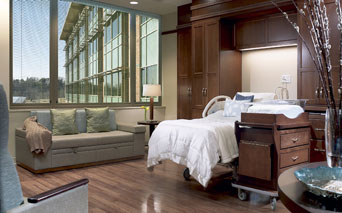
Stafford Hospital in Stafford, Va., designed by Ellerbe Becket.
As early measures of the 2010 Patient Protection and Affordable Care Act come into effect, hospitals and medical centers are working to evaluate their own facilities and care methods in preparation for future changes. Still on their way are portions of the bill aimed at changing hospital environments and providing incentives to high-performing medical facilities.
Signed into law by President Obama earlier this year, the Healthcare Reform Act will expand coverage to 32 million uninsured Americans at a cost of $940 billion over the next 10 years.
Brian Allamby, director of strategic and operational planning at the international design firm Ellerbe Becket, says it’s the changes in the law that affect the way hospitals are built and run that will dramatically reduce the number of large-scale medical facility projects constructed in the future. Developers and facility operators will be required to evaluate their operations and the effectiveness of their building layouts in order to receive more Medicare funding, he says.
HC+O News spoke with Allamby about the future of the healthcare construction industry and changes he believes are on the horizon for existing facilities.
Q: Which parts of the healthcare reform law will affect hospital infrastructure development?

A: The whole bill is going to change the way healthcare is delivered in the future because it concentrates on cutting medical costs and on improving quality and safety. To survive, healthcare providers will need to demonstrate the quality of their performance and their care to the consumer. They will have to better manage their costs and their Medicare and Medicaid reimbursements as well, the latter of which will depend largely on the quality of care they provide.
Healthcare organizations must also get a solid handle on patient satisfaction levels. Under the new bill, consumers are going to have more choice in their medical providers. The consumer will have greater data on the quality of care provided by healthcare organizations, allowing for more consumerism across the market.
In conjunction with this greater emphasis on patient satisfaction, the continuum of care (medical services offered patients from the beginning to end of their treatments) provided will also become important. We will likely see an expansion of services such as wellness, home health services and rehabilitation care built into hospital development, increasing overall efficiency for healthcare providers and patients.
Q: Will hospital infrastructure development suffer?
A: I don’t think I’d use as strong a word as suffer. I think it will be challenging in the future for healthcare facilities. With the economic downturn, we’ve seen the domestic healthcare market significantly slow down its design and construction activity. I think many providers are waiting to see what the future will bring in terms of the economy and healthcare reform. I believe that the bill we see today won’t be the same bill we see a year from now. A lot of the adjustments may depend on the outcome of this November’s elections, and I think we’re going to witness multiple iterations of the reform bill before, and if, it finally takes effect in 2014.
We are starting to see more activity amongst our healthcare clients, but they are often not taking on full design and construction projects. Instead, they are implementing a more strategic approach to facility planning as they try to figure out the best way to cut costs and increase their capacity to meet the objectives of the new bill.
I think we’re going to see healthcare organizations take a serious look at their existing investments. Due to the high cost of construction in healthcare and the decrease in reimbursements providers will receive from Medicare and Medicaid, healthcare organizations are not going to have the capital to easily go out and build a replacement facility. Many of the medical facilities existing today were built in the 1950s and the 1960s, when the government gave out large chunks of money to build hospitals. The infrastructure of those facilities is antiquated and often unable to support today’s technology. However, to build new is an expensive undertaking. Oftentimes, outdated hospitals don’t have the IT infrastructure within the facility plus they don’t have private rooms — a feature the consumer has come to expect in a hospital — as most of the facilities from the 50s and 60s were semi-private or ward-based.
With capital shrinking in the future, hospitals will need to look at how they can deliver care within their existing infrastructure. They will need to find innovative ways to use current resources and capitalize on existing facilities, beginning with healthcare information technology integration. Likewise, they will need to better align space planning with changes in care delivery.
In general, hospitals are laid out to deliver care not based on disease management but more around treating the particular incidents of illness with individualized units set aside for cardiology, orthopedics, etc. To succeed, healthcare facilities will need to be reorganized to better address disease management. Whether it’s done through new construction, affiliations with other organizations or purchases of other facilities, it’s going to be a strategic decision on behalf of the hospital or organization.
Q: What are hospitals going to have to do to flourish in this new environment?
A: To flourish, they are going to have to better control their costs. They will have to plan their facilities in a manner that is operationally efficient, and they’ll need to be more efficient in terms of staffing and throughput in their emergency departments, diagnostic imaging areas, and operating rooms. Plus, they’ll need to increase their volume of throughput by arranging these particular departments so they are more functional and efficient.
Healthcare providers will need to look closely at their emergency departments to determine whether or not they are treating the right patients. You see a lot of facilities with emergency departments that are clogged up with patients who do not have a primary care provider, so they visit the emergency department instead. That trend creates a bottleneck for the entire facility, and hospitals need to look at alternative ways of facilitating that care. This is an issue now, and I think we’re going to see such problems increase in the future because there will be many more people with insurance who don’t have a primary care physician and instead will continue to seek care at the emergency room.
Q: How is hospital design going to change with the new law?
A: Operational efficiency will be key. Healthcare facilities will have to become very efficient, very modular and need greater flexibility in the future to respond to changes in the way healthcare is delivered. By flexible, I mean flexible spaces, i.e. operating rooms that are all about the same size. Operating rooms that aren’t designed for any specific surgical use can better accommodate imaging equipment for operative imaging in the future, as well as changes in technology and the methodology through which care is provided.
Q: To sum it all up, do you think we’ll see fewer new facilities in the future except those needed to replace antiquated buildings?
A: I think we’re going to see holding patterns continue for the next three or four years in terms of big design projects. There are a number of significant projects that went on hold when the economy turned. I think we’ll see those projects start up again over the next two to three years. We’re going to see a lot of organizations revert back to the planning stage to ensure that what they have on hold is appropriate for the changing healthcare environment. I think we’re going to see an up-tick in acquisitions and an up-tick in new construction for those pre- and post-hospital medical services, i.e. wellness and rehab centers, as well as the redesign of existing facilities to make them operate more efficiently.
Ellerbe Becket
Ellerbe Becket





